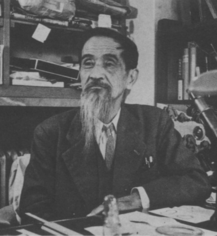Yasuhiko Asahina
Yasuhiko Asahina (朝比奈泰彦 Asahina Yasuhiko; April 16, 1881 – June 30, 1975) was a Japanese chemist and lichenologist. The standard author abbreviation Asahina is used to indicate this person as the author when citing a botanical name.[1]
Yasuhiko Asahina | |
|---|---|
 Yasuhiko Asahina, 1959 | |
| Born | April 16, 1881 Tokyo, Japan |
| Died | June 30, 1975 (aged 94) |
| Nationality | Japanese |
| Alma mater | University of Tokyo |
| Scientific career | |
| Fields | Lichenology |
| Institutions | University of Tokyo |
| Notable students | Syo Kurokawa |
| Author abbrev. (botany) | Asahina |
Early life
During his childhood, Asahina developed an interest in plants. In 1902, he enrolled in the School of Pharmacy at Tokyo Imperial University, from which he graduated in 1905. Asahina stayed at the university to research the chemical principles of Chinese traditional medicine under Junichiro Shimoyama. His first paper on styracitol isolation from Styrax obassia was published in 1907. In 1909, Asahina travelled to Zurich to study phytochemistry under Richard Willstätter. He continued his research on chlorophyll until 1912, when he moved to Berlin. He spent three months in Germany working in the laboratory of Professor Emil Fischer on a styracitol experiment.[2]
Career
Upon his return to Tokyo, Asahina accepted an associate professor position at Tokyo Imperial University. For the next decade, Asahina was devoted to researching traditional and folk medicines of China and Japan. In 1925, he shifted his focus to lichens.[2] He had trouble identifying the lichens he wished to research, as at the time Atsushi Yasuda was the only lichenologist in Japan.[3] Asahina realized that some morphologically identical lichens contained different chemical compounds. Asahina came up with a method of thalline color reaction and the microcrystal test of lichen metabolites. He utilized this chemical identification for taxonomic differentiation of these lichens.[2] Using this method, he helped clean up the taxonomy of the genus Cladonia. He also studied many other genera in Japan, most notably Alectoria, Anzia, Cetraria, Lobaria, Parmelia, Ramalina and Usnea.[3] The technique was taught to Alexander William Evans, who introduced it to western technologists in 1943.[2]
Asahina retired from the University of Tokyo in 1941. In 1954, he founded the Japanese Society for History of Pharmacy (Nihon Yakushi Gakkai, 日本薬史学会).[4] Asahina continued his research activity at his private laboratory until his death in 1975.[2]
Awards
Asahina was awarded the Imperial Prize of the Japan Academy in 1923 for his contribution to research on Chinese drug principles.[2] In 1943, he received the Order of Culture.[5]
Legacy
Syoziro Asahina, notable entomologist, was Asahina's son.[6] The lichen genus Asahinea was named in honour of Yasuhiko Asahina.[7]
References
- IPNI. Asahina.
- Shibata, S. (2000). Yasuhiko Asahina (1880-1975) and His Studies on Lichenology and Chemistry of Lichen Metabolites. The Bryologist, 103(4), 710-719. Retrieved from http://www.jstor.org/stable/3244334
- Syo Kurokawa: Yasuhiko Asahina (1881-1975), The Lichenologist, Band 8, 1976, S. 93–94, pdf
- http://yakushi.umin.jp/englishhome.htm
- Harota, N. (2016). History of Modern Chemistry. Balwyn North Victoria: Trans Pacific Press.
- Tsukané Yamasaki: In Memoriam: Syoziro Asahina (1913–2010). In: Species Diversity. Band 16, 2011, S. 81–83.
- Culberson, William Louis; Culberson, Chicita F. (1965). "Asahinea, a new genus in the Parmeliaceae". Brittonia. 17 (2): 182–191. doi:10.2307/2805243.